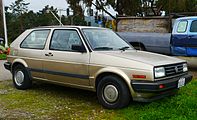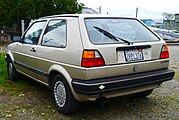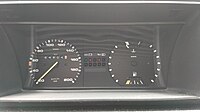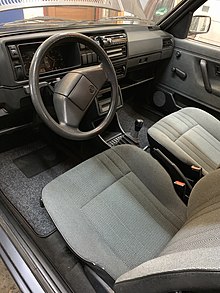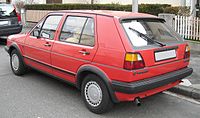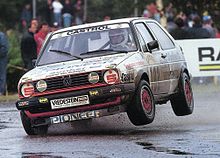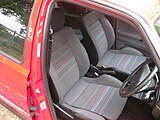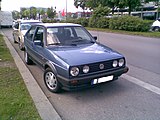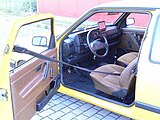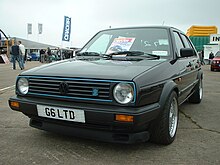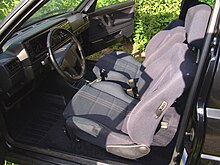VW Golf II
| Volkswagen | |
|---|---|
|
Golf CL
|
|
| Golf ( type 19E / 1G1 ) | |
| Production period: | 1983-1992 |
| Class : | Compact class |
| Body versions : | Station wagon |
| Engines: |
Otto engines : 1.3–1.8 liters (40–155 kW) Diesel engines : 1.6 liters (40–59 kW) |
| Length: | 3985-4040 mm |
| Width: | 1665-1680 mm |
| Height: | 1415 mm |
| Wheelbase : | 2475 mm |
| Empty weight : | 845-1165 kg |
| Previous model | VW Golf I. |
| successor | VW Golf III |
The Volkswagen Golf II (VW internal designation: Type 19E or 1G1 from 1989, 19EL for commercial vehicle version ) is a vehicle type of the Volkswagen brand that was built over 6.3 million times between August 1983 and December 1992. It replaced the Golf I presented in 1974 in the compact class. The successor to the Golf II was the Golf III , which was produced from autumn 1991 .
The Golf II continued the technical concept of the first Golf, but grew in terms of external dimensions and performance. Like its predecessor, the Golf II was available as a three- and five-door hatchback sedan. The Jetta notchback sedan based on the Golf II was offered from February 1984. The Golf Cabriolet , which was still derived from the first generation, remained in production until August 1993; no convertible offshoot was developed on the basis of the Golf II.
The Golf II was the first VW that was designed for automatic production with industrial robots . The Golf II was able to seamlessly build on the great sales success of the previous model and became one of the most frequently produced automobiles of the 1980s and early 1990s.
Model history
General
The design was already established around 1979 and hand-made prototypes were being tested from 1980. In August 1983 the Golf II (Type 19E) was presented, initially in the equipment variants C, CL, GL and GLX (later referred to as Carat ).
As the successor to the Golf I, the second edition continued to follow the hatchback concept of its predecessor. Compared to its predecessor, the car was 17 cm longer, the wheelbase increased by 7.5 cm and the curb weight in the smallest engine increased by 95 kg. In order to keep the drag coefficient (C w value) low, the car was given a more rounded design. With the same appearance with characteristic round headlights and a wide C-pillar , the C w value was significantly lower (0.34 instead of 0.42) and the cross-sectional area was slightly larger than in the predecessor.
Corrosion protection , which was improved in the last model year 1983 of the Golf I, was perfected. Especially in vehicles produced up to 1978, the predecessor showed considerable rust problems even after a few years. In contrast to the predecessor, all of the equipment versions, including the basic Golf C model, have all sheet metal parts in the interior. As standard, the Golf II was delivered with a narrow spare wheel in the trunk floor instead of a normal-sized spare wheel , which has advantages in terms of weight and space. A full spare wheel was also available at an additional cost. The trunk floor mat then protrudes into the trunk with a corresponding curvature.
From model year 1989 onwards, all models with an output of 51 kW or more received a five-speed gearbox as standard. Many of today's standard equipment such as power steering, ABS (from February 1987), power windows, central locking and pollen filters were offered for the first time in this Golf model, albeit at high prices in some cases (1990: power steering DM 795 , ABS 1,800 DM, front power windows 595 DM (front and rear: 995 DM), central locking five-door 490 DM (three-door: 460 DM), pollen filter 146 DM). An airbag was only available from 1992 with the successor Golf III.
technology
New gasoline engines with four-valve technology expanded the range upwards and more economical turbo-diesel engines were introduced. In addition, a wide range of comfort features such as central locking , power steering , heated seats and all-wheel drive were available for the first time at an extra charge (Golf syncro , early 1986).
Airbags were not available and ABS was only available from the beginning of 1987 for a high surcharge and only for selected engines. After large numbers of new, long-term value-preserving measures (wax flooding of the entire body shell, wheel arch liners, seam sealing and mechanics that are not too complex), numerous Golf IIs are still in use in Germany over 24 years after production was discontinued. On January 1, 2013, a good 126,000 VW Golf IIs were still registered in Germany, despite high taxation, according to the Federal Motor Transport Authority .
From 1985 an uncontrolled catalytic converter was available for DM 720 for the 40 kW engine and a G-Kat with lambda control for DM 1,880 for the 66 kW engine .
Note for the following designs: Annual figures refer, unless otherwise specified, always the model year (MY), which in each case after the works holidays starts last year and ends in that year before the vacation.
photos
overview
- 1983: The Golf II (Type 19E) is presented in August
- 1984: GTI and the new type of catalytic converter in the Golf
- 1986: Syncro (type 19E-299 with all-wheel drive), GTI 16V, anti-lock braking system (ABS) for the models GT , GTI and GTI 16V at extra cost. The Carat equipment version will be discontinued at the end of the model year, the GL upgraded.
- 1987: Facelift in August for the 1988 model year. The new features include the omitted triangular windows in the front doors, exterior mirrors attached further forward near the A-pillar and a radiator grille with only five ribs and a larger VW logo. At the rear, the “VOLKSWAGEN” logo and the VW emblem on the left are omitted; the latter is now - significantly larger - in the middle under the tailgate, the model designation on the rear right is in a new angled font. In the interior there are new steering wheels, new seats, thicker steering column switches and better standard equipment.
- 1987: GT / GTD / GTI Special
- 1988: 10 million golf
- 1988: new handbrake lever
- 1989: Facelift in August for the 1990 model year, at the same time new VW-internal type designation 1G1 (instead of 19E): New central electrics , steering column cladding , hazard warning switch now on the steering column, new large bumper cladding (partly painted in body color, optionally integrated fog lights in DE) Technology) for GL and GTI as well as new front seats with larger plastic panels and more stable interior of the backrest.
- 1989: Special model Golf Limited in January, with 16V G60 engine with 210 hp and all-wheel drive ( Syncro ), limited to 71 pieces, price 1989: 68,500 DM
- 1989: Special model Rallye Golf with G60 engine with 160 hp, widespread body and permanent all-wheel drive (Syncro), limited to 5,000 pieces
- 1990: The regulated catalytic converter becomes standard equipment in Germany (in Austria as early as 1988), G60 engine now available for (slightly modified) GTI series body
- 1990: Golf Country (all-wheel-drive Golf with off-road look, raised for more ground clearance)
- 1991: G60 also available with Syncro
- 1992: Start of small series production of the Golf CityStromer with electric drive and lead-acid batteries especially for energy suppliers
- 1992: Production of discontinued special models ended in December at the Volkswagen plant in Mosel near Zwickau, after the successor Golf III had rolled off the production line in Wolfsburg since mid-1991
Technical specifications
Golf II up to 66 kW (90 PS) and diesel
| Engine variant | 1.3 | 1.3 cat | 1.6 | 1.6 | 1.6 cat | 1.8 | 1.8 cat | 1.6 D | 1.6 TD cat | 1.6 TD | 1.6 TD (LLK) |
|---|---|---|---|---|---|---|---|---|---|---|---|
| Construction period | (1983-1992) | (1985-1992) | (1986-1991) | (1983-1991) | (1985-1992) | (1983-1987) | (1984-1991) | (1983-1991) | (1989-1992) | (1983-1991) | (1989-1991) |
| engine | 4-cylinder gasoline engine (four-stroke) | 4-cylinder diesel engine (four-stroke) | 4-cylinder diesel engine (four-stroke) with turbocharging | 4-cylinder diesel engine (four-stroke) with turbocharging and charge air cooling | |||||||
| Engine code | HK (1983-1985), MH (1985-1992) 1 |
NZ (1987-1992) | RF | EZ | PN | GU | GX (1984-1988) RP (1987-1992) |
JP | 1V | JR (1983–1991) MF (only 1988) |
RA / SB (1989-1991) |
| Displacement | 1272 cc | 1595 cc | 1781 cc | 1588 cc | |||||||
| Bore × stroke | 75 × 72 mm | 81 x 77.4 mm | 81 x 86.4 mm | 76.5 x 86.4 mm | |||||||
| Max. Power at 1 / min |
40 kW (55 PS) 5400 |
40 kW (55 PS) 5200 |
53 kW (72 PS) 5200 |
55 kW (75 PS) 5000 |
51 kW (69 PS) 5200 |
66 kW (90 PS) 5200 |
66 kW (90 PS) 5250 |
40 kW (54 PS) 4800 |
44 kW (60 hp) 4500 |
51 kW (70 hp) 4500 |
59 kW (80 PS) 4500 |
| Max. Torque at 1 / min |
96 Nm 3800 |
97 Nm 3000 |
120 Nm 2700 |
125 Nm 2500 |
118 Nm 2700 |
145 Nm 3300 |
137-142 Nm 3000 |
100 Nm 2300-2900 |
110 Nm 2400-2600 |
133 Nm 2500-2900 |
155 Nm 2600-3000 |
| Mixture preparation | 1 register downdraft carburetor Pierburg | Electric injection (VW Digijet) | 1 register downdraft carburetor Pierburg | Electric injection (Bosch KE-Jetronic / KA-Jetronic or Mono-Jetronic) | Distributor injection pump | Distributor injection pump + turbocharger (Garrett or KKK) | |||||
| Valve control | OHC , toothed belt, from 08/85 hydraulic valve lifters | ||||||||||
| cooling | Water cooling | ||||||||||
| transmission | 4- or 5-speed gearbox ( standard with 70/90 HP, D Kat and TD), aW (for 70/75/90 HP and naturally aspirated diesel) three-speed automatic |
||||||||||
| drive | Front wheel drive | ||||||||||
| Front suspension | Independent suspension with MacPherson struts , lower triangular wishbones and anti-roll bar (GT and GTD only) | ||||||||||
| Rear suspension | Twist-beam axle with track-correcting rubber bearings and spring struts | ||||||||||
| Brakes | Disc brakes (Ø 239 mm) at the front, drum brakes at the rear (GT: disc brakes at the rear and front internally ventilated) Brake booster, (automatic, 66 kW, 51/59 kW diesel with brake force regulator), from 02/87 aW ABS with disc brakes at the rear |
||||||||||
| steering | mechanical rack and pinion steering, on request with power assistance | ||||||||||
| body | Sheet steel, self-supporting, tank capacity 55 liters | ||||||||||
| Front / rear track | 1413/1408 mm, with wide tires 1427/1422 mm | ||||||||||
| wheelbase | 2475 mm | ||||||||||
| length | 3985 mm, length from model year 1989 4040 mm | ||||||||||
| Empty weight | 845-1020 kg | ||||||||||
| Top speed | 155 km / h | 152 km / h | 162-167 km / h | 157-162 km / h | 162-167 km / h | 173-178 km / h | 170-176 km / h | 150 km / h | 153 km / h | 160 km / h | 169 km / h |
| Acceleration from 0-100 km / h |
16 s | 17 s | 13-15 s | 14-16.5 s | 13-15 s | 11.5-13.5 s | 12-14 s | 19.5-23 s | 18 s | 15 s | 14.5 s |
| Consumption in liters / 100 kilometers |
8.0 N | 8.5 N | 9.5-10.0 N | 10.0-10.5 N | 9.5-10.0 N | 9.5-10.0 S | 9.5-10.0 N | 6.5-7.0D | 7.0 D. | 7.0 D. | 7.5 D |
Golf II syncro, GTI and G60
| Model name | GTI | GTI cat | GTI 16V | GTI 16V cat | syncro | syncro | Country | GTI G60 | G60 Limited | Rally Golf | |||
|---|---|---|---|---|---|---|---|---|---|---|---|---|---|
| Construction period: | (1984-1987) (UK: 1984-1992) |
1985-1988 | 1986-1987 | 1987-1991 | (1986-1987) (UK: 1986-1992) |
(1987-1991) | (1986-1987) | (1987-1991) | (1990-1991) | (1990-1991) | (1989) 71 pieces |
(1989-1991) 5,000 pieces |
|
| Engine: | 4-cylinder in-line engine (four-stroke) | 4-cylinder in-line engine (four-stroke) with mechanically driven G-scroll compressor | |||||||||||
| Engine code | EV (1984-87), PB (1987-92) |
RD | RG | PF | KR | PL | GU / GX | 1P (1988-1991) | PG | 3G | 1H | ||
| Displacement: | 1781 cc | 1763 cc | |||||||||||
| Bore × stroke: | 81 x 86.4 mm | 80.6 x 86.4 mm | |||||||||||
| Performance at 1 / min: |
82 kW (112 PS) 5500 82 kW (112 PS) 5400 |
79 kW (107 PS) 5250 |
79 kW (107 hp) 5500 |
79 kW (107 PS) 5400 |
102 kW (139 PS) 6100 |
95 kW (129 PS) 5800 |
66 kW (90 PS) 5200 |
72 kW (98 PS) 5400 |
118 kW (160 PS) 5800 |
155 kW (210 hp) 6500 |
118 kW (160 PS) 5800 |
||
| Max. Torque at 1 / min: |
155 Nm 3100 159 Nm 4000 |
154 Nm 3250 |
154 Nm 3500 |
157 Nm 3800 |
163 Nm 4600 |
168 Nm 4250 |
145 Nm 3300 |
143 Nm 3000 |
225 Nm 3800 |
252 Nm 5000 |
225 Nm 3800 |
||
| Mixture preparation: | Mech. Injection (Bosch K-Jetronic) or electr. Injection (Digifant) | Mech. (Bosch K-Jetronic) | electr. Injection (Bosch KE-Jetronic) | electr. Injection (Digifant) | Mech. Injection (Bosch K-Jetronic) | Electric injection (Bosch KE-Jetronic) | 1 Register-Fallstrom-Verg./Bosch KE-Jetronic | Electric injection (Digifant) | Electric injection (Digifant) + scroll charger, charge air cooler | ||||
| Valve control: | OHC with 8 valves, toothed belt, hydraulic valve lifters from 8/85 | DOHC with 16 valves, hydraulic valve lifters, toothed belt | OHC with 8 valves, hydraulic valve lifters, toothed belt | DOHC with 16 valves, hydraulic valve lifters, toothed belt | OHC with 8 valves, hydraulic valve lifters, toothed belt | ||||||||
| Cooling: | Water cooling | ||||||||||||
| Drive: | front | All-wheel drive | front | All-wheel drive | |||||||||
| Transmission: | 5 speed transmission | ||||||||||||
| Front suspension: | Independent suspension with MacPherson struts, lower triangular wishbones and anti-roll bar | ||||||||||||
| Rear suspension: | Twist beam axle with track-correcting rubber bearings, struts and stabilizer (syncro: semi-trailing arm axle ) | ||||||||||||
| Brakes: | Disc brakes all around (Ø front 239, rear 226 mm), aW from 02/87 ABS | Disc brakes all around (Ø front 239 mm, from 1990 256 mm, rear 226 mm), aW from 02/87 ABS | Front disc brakes (front Ø 239 mm), rear drum brakes, aW from 08/87 ABS (except Country) | Disc brakes all around (Ø front 280, rear 226 mm), ABS | |||||||||
| Steering: | Rack and pinion steering, on request or partially (all G60 and various special models) with servo assistance as standard | ||||||||||||
| Body: | Sheet steel, self-supporting, tank capacity 55 liters (incl. Syncro and Country) | ||||||||||||
| Track width front / rear: | 1427/1422 mm | 1427/1432 mm | 1435/1442 mm | 1433/1428 mm | 1427/1432 mm | 1435/1437 mm | |||||||
| Wheelbase: | 2475 mm | 2479 mm | |||||||||||
| Length: | 3985 mm (1984–1988), 4040 mm (from 1989), Country: 4255 mm | ||||||||||||
| Empty weight: | 920-1095 kg | 1090-1145 kg | 1220 kg | 1120-1140 kg | 1255-1275 kg | 1250 kg | |||||||
| Top speed: | 191 km / h | 186 km / h | 208 km / h | 200 km / h | 175 km / h | 180 km / h | 163 km / h | 220 km / h | 230 km / h | 210 km / h | |||
| Acceleration from 0-100 km / h: |
9.7 s | 10.3 s | 8.5 s | 9.0 s | 12-13 s | 12 s | 13.5 s | 8.3 s | 7.4 s | 9.5 s | |||
| Consumption in liters / 100 kilometers: |
5.7 / 7.5 / 10.9 S. | 6.1 / 8.1 / 11.3 N. | 9.8 S. | 6.1 / 7.5 / 10.9 S. | 6.4 / 8.0 / 11.3 S. | 11.0 N | 11.0 N | 12.0 N | 12.0 S. | 14.5 p | 13.0 S. | ||
Equipment variants
The most common variants of the Golf II were named C, CL and GL in the order of increasing equipment. The top model was initially the GLX, which was soon renamed the Carat . The sporty GTI variants were the top models in every respect, with the GT and GTD variants in between, combining the GTI look with less powerful engines.
- C (up to model year 1987)
- CL
- GL
- GLX (August to October 1983), then Carat (until August 1986)
- GT (from 1986)
- GTD
- GTI (from January 1984)
Golf C
The C model (Comfort) was the simplest. The simplest (but durable) seat fabrics, minimal technical equipment including rear window wipers, even the front center console, door shelves and a clock were missing. Otto engines were up to 66 kW (90 hp), diesel engines with 40 kW (54 hp) and 51 kW (70 hp). From the first facelift in the model year 1988 this variant was only called "Golf", from model year 1990 (second facelift) it was omitted entirely.
Golf CL
The Golf CL (Comfort Luxus) was equipped with a clock, internal adjustment for the exterior mirror on the driver's side and a center console (from model year 1988) as well as a fabric insert in the door side panels. From model year 1988 new steel wheels were introduced, which from model year 1990 had a silver hub cover (previously black). Engines like the Golf C. The Golf CL was also available with the Syncro all-wheel drive for an additional price of DM 5,700 , then with the 1.8-liter engine with 66 kW (90 hp) initially, later 72 kW (98 hp) ) equipped. Prices in 1990: 18,820 DM (40 kW (55 PS) with 4-speed manual transmission) to 22,635 DM (66 kW (90 PS) with automatic transmission), each without special equipment. Golf CL Syncro: DM 27,850.
Golf GL
Up to model year 1987, the Golf GL (Upper Luxury) was characterized by chrome trim on the outside of the window seals, chrome inlays on the radiator grille and in the bumpers and chrome-plated wheel hub covers. At the same time, when the Carat was discontinued, the GL became the best-equipped standard version. Depending on the model year, additional thermal insulation glazing, high-quality cover fabrics, parapets of the (door) side panels with black synthetic leather cover, wheel arch linings in the trunk, floor and rear shelf clad with black tufted velor and chrome-plated trim, interior light with switch-off delay, a special steering wheel (foamed), a gear lever panel made of synthetic leather (instead of rubber bellows) and hub rings are standard equipment. From model year 1990 onwards, the GL got voluminous bumper panels, some painted in the same color as the car, which were also mounted on the GTI. All engines up to 66 kW (90 PS) were available. Prices in 1990: DM 20,720 (40 kW / 55 PS with 4-speed manual transmission) to DM 24,535 (66 kW / 90 PS with automatic transmission), each without special equipment.
Golf GLX
As a dignified top equipment variant, the GLX was equipped with almost all available optional equipment ex works and thus featured, among other things, partially painted bumpers, a 4-spoke sports steering wheel with a leather rim, a leather-covered gear knob, velor upholstery, a split rear seat with headrests, electrically adjustable and heated exterior mirrors , Power steering, central locking, an instrument cluster with the on-board computer MFA and rev counter and electric windows. It was also only available with four doors. The Golf GLX was only available with the 1.8-liter gasoline engine with 66 kW (90 PS) and only from August to October 1983. Due to the high price, this version was not widely used.
Golf Carat
The Carat replaced the almost identically equipped GLX as early as November 1983, but was discontinued at the end of the 1986 model year, especially since this new luxury variant was rarely sold. After the Carat was discontinued , customers were able to generate an ambience similar to that of the GLX or Carat by selecting numerous expensive additional equipment with the GL .
The Carat did not find an indirect successor until years later in the highline version of the Golf 3 (here, however, only in connection with the VR6 engine).
Golf GT
The standard equipment of this model included a slight lowering by 20 mm, black plastic fender flares, sills covered with black plastic film, black or light gray (depending on the paintwork) decorative strips in the side bead in the body panel, a black adhesive film around the rear window, a rear spoiler the upper edge of the tailgate, the 1.8-liter gasoline engine with 66 kW (90 PS), a rev counter, an on-board computer (multifunction display "MFA" with consumption, distance and oil temperature display) and, first of all, 175/70 R13 tires Decorative rings. From model year 1987 then 14 "steel wheels with black plastic center cover and wide tires of size 185/60 R14. From model year 1990 revised steel wheels with silver center cover and omission of the side and rear decorative strips in the bead. The Golf GT was only available with 5- After the introduction of the special model GT Special in 1987 and its later inclusion in the regular sales brochure, the standard GT hardly played a role anymore, but was retained until the end of production in 1991. Both the Golf CL and the Golf GT were equipped with all-wheel drive ( "Syncro"); it was then equipped with the 1.8-liter gasoline engine with 72 kW (98 hp).
Golf GTD
The Golf GT was available with turbo diesel engines and, like its predecessor, was referred to as GTD (Golf Turbo Diesel): first with 51 kW (70 PS), then from 1989 also with 59 kW (80 PS). The equipment was the same as that of the GT except for the lack of lowering and on-board computer (MFA). In contrast to the GT, the standard GTD was chosen much more often than the special variant, which was rarely found. Price in 1990: DM 24,945 (59 kW (80 PS): DM 25,695) without special equipment.
Golf GTI

The second generation of the Golf GTI was offered from January 1984, and for the first time was accompanied by a larger selection of engines. Initially, only the 1.8 liter 82 kW (112 hp) engine with eight valves known from the old model was available in the GTI. From March 1986 the new 1.8 liter 16V engine with four-valve technology and 102 kW (139 hp) output and 168 Nm torque. In February 1987 the 16V engine with catalytic converter and 95 kW (129 hp) was presented, a catalytic converter version of the 82 kW engine came onto the market in January 1987 with 79 kW (107 hp).
From 1990 the engine with mechanical G-charger, already known from the Rallye Golf, was available in the GTI G60 with 118 kW (160 hp) . Among other things, the G60 was equipped with a cable-operated gearbox and the 15 "brake system from the Passat and had a glued-in windshield to increase the torsional rigidity of the body. It was the only GTI variant available with syncro all-wheel drive . The most powerful engine had the Golf Limited built only 71 times in 1989 by the VW Motorsport department , which combined four-valve technology with the charging of the G-Lader and thus developed 155 kW (210 hp). It contained almost every possible special equipment as standard, which is also clearly reflected in the price From the outside it was very inconspicuous - only the light blue decorative frame on the radiator grille (with single headlights), the "VW Motorsport" badges on the front and rear and the two-part 15 "aluminum wheels from BBS were more or less unique identifying features.
The GTI-specific appearance, such as the enlarged front lip on the bumper, rear spoiler on top of the tailgate, red decorative frame on the double headlight grille, etc., was partially retained with the facelifts for model year 1988 and 1990 of the Golf II and, for example, with large-volume bumper panels Front and rear fog lights in DE technology added. In the USA, the 2.0l-16V from the Passat was installed in the GTI from model year 1990 onwards, as this could also be operated with regular petrol in order to take account of the poorer petrol quality there.
The GTI was in the 1989 model year as a special model Special order, since the same year there was also the special model Edition One , that came with a lot of fittings and light optical changes to the end of production in October 1991, this series joined in 1991 to complete the special edition Edition Blue .
While the GTI, with its numerous variants, only accounted for around 2% of total production of the Golf II in Germany, every sixth Golf II in Great Britain was a GTI (around 16%), with only the catalytic converter-less engine variants with 82 kW / 112 PS and 102 kW / 139 PS (16V) were offered. In the last model years 1990 to 1992 the 16V variant and from 1991 also the 8V version were upgraded in addition to the German standard equipment with elements of the special model GT Special : its 15 "-BBS aluminum wheels with 195 / 50R15 tires and the interior were taken over (so-called rainbow interior ). Furthermore, power steering, electric windows and exterior mirrors, a Panasonic car radio and a steel sunroof were available as standard. Only the number of doors and the paintwork were available. ABS was not available on the Golf II in Great Britain because for There was no space for the control block on the master brake cylinder, which is attached to the right behind the engine.
The variants Rallye Golf and Limited are not GTIs in the strict sense of the word (they also do not have the abbreviation in their name), similar to the VR6 in the Golf III .
Prices 1990 (each without special equipment):
- GTI with 79 kW (107 PS): 28,545 DM
- GTI 16V with 95 kW (129 PS): 31,100 DM
- GTI G60 with 118 kW (160 PS): 37,125 DM.
Special models (Germany)
- 1985: Match
- 1986: Hit; Fun; Flair; Pikes Peak (rally car, until 1987)
- 1987: bistro; Memphis; Sky; GT / GTD / GTI Special (until 1991); Berlin Golf; Brigitte
- 1988: tour; Manhattan; Champion; 10 million
- 1989: Öko Golf (test vehicle, until 1992); Atlanta; Boston; City Stromer; GTI Edition One (until 1991); Limited (VW Motorsport, 71 pieces); Rally Golf
- 1990: Black Line - Red Line; Country ; Country all-round; Country Chrome Package; Country GTI (only in-house); Fire and Ice (until 1991); Madison; Moda; Quadriga
- 1991: Pasadena ; Function; GTI Edition Blue ; Barcelona; Dynamite (kamei)
Special models: logos
The basis for all special models is the Golf CL , exceptions: GT / GTD / GTI Special , GTI Edition One , GTI Edition Blue and the GTI variants of the Fire and Ice .
10 million golf
To mark the anniversary of the ten millionth Golf sold, VW launched the 10 million special model in 1988 . This model was available with various petrol engines between 40 kW (55 PS) and 66 kW (90 PS) (1.8 l 66 kW also with an injection engine, but never as a GTI) and as a turbodiesel with 51 kW (70 PS), optionally as a 3- or 5-door. These models can be recognized by the special paint finish Starblue metallic (LD5T), painted exterior mirrors with aspherical (left) or convex (right) glass, blue thermal insulation glazing (the only Golf II with blue tinted glazing), side indicators, half-darkened rear lights, blue stripes in the bumpers, the special 14 "aluminum wheels with blue drops (VW-LM-Rad Silverstone ) and three stickers below the Golf logo on the rear panel and above the side indicators. In addition, the 10 million golf always had the black plastic Inside it differs from the standard models with blue velor carpet, sports seats with height adjustment on the driver's seat in special blue striped velor, blue hat shelf, blue striped door and side panels that match the seats and illuminated makeup mirror. The special paintwork was Not available for any other Golf II model, as well as the interior and the rä the one with blue drops. The double headlights, as they can be seen in the picture, were not part of the original equipment of the 10 million golf. They were included in the price list as optional equipment for all models with single headlights (CL, GL and special models) from model year 1985 and were available as high beam or fog lights. On the Golf GL from model year 1990 the fog lights in DE version were embedded in the large bumpers, here the optional additional lights in the radiator grille were always high beam.
Golf Country
Volkswagen presented this version as a “Golf Montana” study, initially without seriously thinking about building it. After that, the dealers immediately received orders, even though the car was not supposed to go into series production. That is why VW decided to build a series of this car.
The Golf Country , introduced in May 1990 and produced until December 1991, is an equipment variant of the Golf CL syncro with four doors. Series production at Steyr-Daimler-Puch (now Magna Steyr ) in Graz (Austria) began in April 1990. For this purpose, a completely preassembled Golf CL syncro with a 72 kW motor was delivered to Graz and converted there into a Golf II Country .
Specifically, the body was placed 120 mm higher with a tubular frame underneath, a protective tube frame ("ramming bar") with integrated engine protection was installed at the front and two protective tube frames were inserted into the bumper at the left and right of the foldable spare wheel holder. In order to be able to maintain the drive train, the engine was moved downwards. This resulted in an increased ground clearance of at least 63 mm (to 180 mm) compared to the normal Golf (Syncro). Due to the lack of differential locks, the terrain properties were never particularly good. Like the Golf Syncro, the Golf Country has a much smaller trunk (the trunk floor is roughly level with the top edge of the bumper, while on front-wheel drive models it is roughly level with the bottom edge of the bumper). This was necessary for the Syncro models to accommodate the differential gear on the rear axle .
From July 1990 the second variant, the Golf II Country Allround, was added. This variant had equipment that was tailored to functionality and less to comfort (for example synthetic leather inside, standard wheels in body color). This variant was only available in the color "forest green". Only 160 vehicles of this variant were built.
From the beginning of 1991, VW brought a third equipment variant onto the market - the chrome edition. Its equipment with cream-colored real leather interior, electric folding sunroof and chrome-plated attachments caused an enormous price surge - this luxury version cost 52,200 DM at the time and was only available in black. Only 558 pieces of this special edition were built.
There were also some special versions and special conversions, such as the Golf II Country GTI with 79 kW (107 PS), of which 50 were built exclusively for VW employees (Wolfsburg edition), or special conversions for other Otto and diesel engines.
Already in 1989 ruled the SUV magazine Off Road , the car was that "precisely in the gap fits that then opens up when one SUV to conventional interpretation and-road four-wheel drive passenger cars apart moves a little further."
If you look at the SUV wave that has been rolling inexorably since the mid-1990s , it can only be said that the Golf II Country was a trendsetter, Simca brought a vehicle with the Simca Rancho as early as 1977 and AMC with the AMC Eagle in autumn 1979 on the market, the concept of which was very similar to that of the Golf II Country. In addition to a sedan and station wagon, the AMC Eagle was also available as a coupé and shooting brake . Toyota copied this concept in a similar form with the RAV 4 in 1994 and achieved great success in the soft roader market.
Golf GT / GTD Special
Based on the GT or GTD, the GT / GTD Special was added to the sales program with the 1988 model year. The designation "special model" is perhaps not entirely correct, because the special equipment was regular alongside the normal standard equipment CL, GL, GT, GTD and GTI until the end of production of the Golf II with the 1.8-l engine with 66 kW and the turbodiesel engines with 51 (up to model year 1989) or 59 kW (from model year 1990) are available. In the model years 1988 and 1989, the special model Special was also available as GTI and GTI 16V with the same equipment.
The equipment (different from the GT / GTD):
- Special paint finishes black blue and oak green metallic as well as standard paint finishes brilliant black metallic, black, atlas gray metallic and royal blue metallic
- "Special" lettering on the C-pillars
- Color glazing green
- Tail lights partially darkened
- Interior in anthracite with “Color GT stripes”, seat backs and side bolsters covered with black synthetic leather, floor and rear shelf clad with black tufted velor
- Sports seats in the front, rear bench seats with the character of a single seat
- Lowering by 10 mm (not with GTD Special)
- dark gray roof lining and black C-pillar trim, rarely with a tinted interior light
- Optionally Recaro sports seats in gray with red stripes, then adaptation of the side panels to the seat fabrics, elimination of the Color GT stripes
- Multi-function display (not for GTD Special)
- Radio Gamma with two active speakers in the front doors
- Aluminum wheels with cross-spoke design BBS RM 6J × 15 with 185 / 55R15 tires
- internally ventilated brake discs in front and brake discs in rear (GTD special: full brake discs in front, drum brakes in rear)
Price 1991: 28,085 DM (GT Special with 90 PS), 29,050 DM (GTD Special with 59 kW / 80 PS).
Golf Fire and Ice
The special model "Fire and Ice" was offered in the model years 1990 and 1991. The name was given to the film Feuer, Eis & Dynamit with Roger Moore and Simon Shepherd, directed by Willy Bogner junior .
The engines were the 1.8-liter gasoline engines with 66 kW (90 PS), 79 kW (107 PS), 95 kW (129 PS), 118 kW (160 PS) and the 1.6-liter turbo diesel with charge air cooling and 59 kW (80 PS) to choose from.
Depending on the engine, the Golf Fire and Ice was based on the CL, GTD and GTI models, which, however, were not distinguishable from the outside due to corresponding optical adaptations ( apart from the differently deeply lowered chassis , brake system designs and different tailpipes)
- Special paint "Dark Violet perleffect" (color code: LC4V) for all models
- Look of the GTI (wide sill panels, wheel arch extensions, narrow decorative strips on the doors, large partially painted bumpers, painted handle strip on the tailgate)
- Exterior mirror housings painted in body color
- large round logos as stickers on the C-pillars
- round “Fire and Ice” emblems on the front fenders instead of the side indicators
- Rear lettering in pink
- Graphic emblem next to the rear lettering "Golf"
- special interior fittings in violet / blue with large embroidered emblems on the backrests of the standard sports seats, carpet and headlining black and anthracite
- "Fire and Ice" emblem on the front ashtray
- Aluminum wheels 6 × 15 "Estoril" with 195 / 50R15 tires
Golf Pasadena
The Golf Pasadena was a sporty special model of the Golf II (equipment code E3K), which was offered in the 1991 model year. Special features of the special model were a double headlight grill with additional high-beam headlights, sports seats in the so-called "Colibri design", white front indicators and side indicators on the fenders. Black flared fenders, bumpers with colored decorative stripes, perforated 14-inch steel wheels for 185 mm wide tires and black sills made for a sporty impression. The four-spoke sports steering wheel was installed in the interior, the gear lever gaiter was made of synthetic leather and the gear lever knob was foamed. In addition, there was the green heat-insulating glass, height-adjustable belts for the front seats, a height-adjustable seat on the driver's side, window sill in synthetic leather, loading sill cover and lighting for the luggage compartment, as well as a rev counter and digital clock in the instrument panel. The "Pasadena" lettering was affixed to the C-pillars and at the bottom right of the rear.
Motor variants offered:
| Engine code | Displacement | power | transmission | |
|---|---|---|---|---|
| Otto engines: | ||||
| NZ | 1,272 cc | 40 kW (55 PS) | 4-speed | |
| NZ | 1,272 cc | 40 kW (55 PS) | 5-speed | |
| PN | 1,595 cc | 51 kW (70 hp) | 5-speed | |
| PN | 1,595 cc | 51 kW (70 hp) | Automatic | |
| RP | 1,781 cm³ | 66 kW (90 PS) | 5-speed | |
| RP | 1,781 cm³ | 66 kW (90 PS) | Automatic | |
| Diesel engines: | ||||
| JP | 1,588 cc | 40 kW (54 PS) | 4-speed | |
| JP | 1,588 cc | 40 kW (54 PS) | 5-speed | |
| 1V | 1,588 cc | 40 kW (54 PS) | Automatic | |
| 1V | 1,588 cc | 44 kW (60 hp) | 5-speed | |
| MF | 1,588 cc | 51 kW (70 hp) | 5-speed | |
| RA | 1,588 cc | 59 kW (80 PS) | 5-speed | |
Golf function
Shortly before the introduction of the Golf III, Volkswagen brought out this special model. The production location was Wolfsburg, Mosel / Zwickau and in Sarajevo at TAS ( Tvornica Automobila Sarajevo) . Models from Sarajevo can be recognized by their vehicle identification number (VIN), which is marked with a "T".
Example: WVWZZZ1GZN T XXXXXX. (T = Sarajevo / "Yugoslavia" until 1994)
However, production in Sarajevo ended in 1992 due to the Bosnian War. The Golf II Function was built from 1991 to 1992, in the end parallel to the Golf III . Buyers expected particularly good quality from this new plant in the "East". From the outside, the Golf II Function can be easily recognized by the silver colored "Function" lettering on the C-pillar, the widened wheel arches and the missing C or CL lettering on the rear. It was available in six colors (tornado red, maritime blue, alpine white, capri green, royal blue and pearl gray) and with four different gasoline engines (40 to 66 kW) and four diesel engines (40 to 59 kW). These could be combined with a four- or five-speed manual transmission or an automatic. Other standard equipment included green heat-insulating glass, height-adjustable driver's seat, rear-view mirrors adjustable from the inside and air vents for the rear footwell. This model was manufactured with two or four doors. The price for a two-door model with standard equipment ranged between DM 17,611 (gasoline engine with 40 kW, four-speed transmission) and DM 21,314 (diesel engine with 59 kW, five-speed transmission).
Post golf
For delivery services, there was a special model with an independent 2-point seat belt from the US models (attached to the door instead of the B-pillar), a partition net and a modified passenger compartment from the B-pillar for improved use of space.
GTI special models
Golf GTI Special
In the model years 1988 and 1989 the GTI and GTI 16V were available as a special GTI Special ; however, this combination was rarely ordered. Features like GT Special .
Golf Limited
Although not officially listed as a GTI, this special edition of the Golf belongs in this category due to the engine. The Golf Limited was hand-built in 1989 by VW Motorsport in 71 copies. The heart of the car was the engine that was only made for this model: a modified 1.8-liter engine with 16 valves and a G60 scroll charger with 155 kW (210 hp) at 0.54 bar boost pressure. The Limited was equipped with the Syncro all-wheel drive. The torsional rigidity of the body was increased by the bonded windshield. In 2018 a copy - the number 003 - was offered for 110,000 euros.
Outside the Limited was inconspicuous, only the light blue frame around the radiator grille with individual headlights and the black "VW Motorsport" badges on the radiator grille and rear panel were recognizable. The standard two-piece BBS aluminum wheels RM012 with 15 "were also standard on the GTI G60 from 1990 and on the special Edition One and Edition Blue models. The US version also featured the front bumper as standard. The Limited was only available in the five-door body variant was always painted in black metallic (color code LP9V) with the following equipment (based on GTI basic equipment):
- heated leather seats at the front, manually adjustable in height and inclination
- Full leather equipment (front / rear seats, door panels, steering wheel, gear knob, handbrake lever sleeve)
- GTI 16V ignition key with VW motorsport keyring
- electric sunroof
- Anti-lock braking system (ABS
- Power steering
- electric windows (front and rear)
- central locking system
- Aluminum badge with serial number on the lock carrier as well as a separate ABE badge from VW-Motorsport AG Hannover
- electrically adjustable exterior mirrors, heated
- tinted rear lights (black above, red below)
- Gamma radio / audio system with VW active speakers
- US front bumper
- heatable nozzles for wiping / washing systems
There were no further optional extras because of the full equipment. Fog lights or automatics were not available.
Rally Golf
The Rallye Golf was also not referred to as a GTI, but with its 1.8 l engine with G scroll charger and 118 kW (160 hp) it also belongs to this department. This special model for road traffic was built as a homologation model in the years 1989 to 1991 for rally use in an edition of 5,000 pieces in the VW plant in Brussels. In order not to have to compete with more powerful vehicles, the displacement of the series G60 engine was reduced from 1781 to 1760 cm³, which meant that it still fell into the 1700 cm³ category. A larger charge air cooler was used to compensate for the slight loss in performance due to the smaller displacement. There were only 50 copies without a sunroof and with a full leather interior that were only exported to Switzerland. Twelve units were also built by VW Motorsport, which were delivered with the modified 1.8-liter, 16-valve engine and G60 scroll supercharger that developed 155 kW (210 hp).
In addition to the beefy body with significantly widened fenders and side parts (but standard doors) and wide sill reinforcements, the radiator grille painted in the body color with the angular DE double headlights was noticeable.
The further equipment:
- only available as a three-door model
- All-wheel drive - Syncro
- Anti-lock braking system (ABS
- Power steering and sports steering wheel
- Aluminum wheels 6J × 15 with 205 / 50R15 tires
- Electrically adjustable exterior mirrors
- Sports suspension
- Special bumpers painted in body color with front spoiler and cooling air ducts for the front brakes
- Rear spoiler also painted in body color
- Sports seats (on request: Recaro sports seats, electrically adjustable), seat and backrest surfaces with checked fabric, side bolsters covered with leather
- Door and rear side panels covered with leather
- sunroof
In addition to the Recaro sports seats, central locking, electric windows, electric mirrors and various radios were available as special equipment.
Golf GTI Edition One
With the model year 1989 this special model was included in the regular GTI sales brochure. It was available as a GTI with 79 kW, as a GTI 16V with 95 kW and as a GTI G60 with 118 kW. By the end of production in 1991, around 12,000 units had been produced.
In addition to the standard GTI / GTI 16V / GTI G60, the equipment included:
- Special finish quartzite metallic and dark burgundy pearl effect or standard finish brilliant black metallic and pearl gray metallic
- Edition One sticker on the front left of the bonnet
- Elimination of the red decorative frame on the radiator grille
- round emblems ("Wolfsburg Edition") on the fenders instead of the side indicators
- Exterior mirrors painted in body color
- G60 fender flares all around (from January 1990)
- 16V exhaust system (55 mm, only until June 1990) also for 79 kW (107 PS)
- Aluminum wheels BBS RM012, two-part, 6.5J × 15 ET33 with 195 / 50R15 tires
- Tail lights partially darkened
- white flashing lights in front
- Power steering with four-spoke steering wheel (370 mm) with leather rim
- Shift knob and handbrake lever handle covered with leather
- Interior in blue: side panels and standard sports seats covered all around with Mauritius blue fabric and with Edition lettering on the backrest (manual height adjustment on the driver's side for the 79 kW motor), electrically adjustable Recaro sports seats in the same fabric with Recaro lettering for versions with 95- kW (16V logo in the headrests until 08/89) and 118 kW engine (not in conjunction with leather upholstery). Rear bench seat with the character of a single seat (also available with headrests). Floor and rear shelf clad with Mauritius blue tufted velor.
- Luggage compartment cover and side consoles with Mauritius blue carpet
- Door and side panels in Avantage fabric, Mauritius blue-blue - red-silver with two black decorative strips
- The three-door cars were fitted with siglachrome window panes on the sides and in the tailgate , which were chrome-coated and darkened significantly more than the normal green heat-insulating glass
The normal special equipment such as a choice of three- or five-door, complete leather, sunroof, electric windows, various radios, air conditioning and ABS were possible.
Golf GTI Edition Blue
The Edition Blue was a special model limited to 2100 vehicles in the last year of production 1991 on the occasion of the end of production of the Golf II. It was only sold in Germany, Austria and Switzerland and was exclusively produced in Wolfsburg . 1,749 pieces were intended for the German market.
Features of the Edition Blue:
- only available as a three-door model
- Painting LC5M (moonlight blue pearl effect)
- Engine: 1.8 l with 79 kW (MKB: PF) for Germany; 1.8 l with 118 kW (MKB: PG) ( G60 ) for Austria and Switzerland
- 3 Edition Blue emblems instead of the GTI emblems on the side strips and on the rear
- G60 fender flares all around
- Aluminum wheels BBS RM012, two-part, 6.5J × 15 ET33 with 195 / 50R15 tires
- Steel sliding roof with manual operation
- Side indicators
- Tail lights partially darkened
- Exterior mirrors, electrically and heatable, painted in body color (right convex, left aspherical wide-angle)
- Interior exclusively in Mauritius blue leather with heated seats at the front
- Carpet in tufted velor Mauritius blue
- 3-spoke sports steering wheel, 360 mm, black leather
- Gear lever knob in black leather
- Black leather handbrake handle
The G60 models for Austria and Switzerland had air conditioning and ABS as standard . In Switzerland the Edition Blue could only be ordered as a G60, only there it could be configured with additional equipment. ABS was (as with all G60s in Switzerland) not standard, but only available at an additional cost. In Austria and Germany, no additional optional equipment could be ordered for this special model.
production
The Golf II was produced in Wolfsburg, Zwickau, Graz, Brussels, Sarajevo, Uitenhage / South Africa, Lagos / Nigeria, Westmoreland County / USA and in Puebla / Mexico. The degree of automation has been increased in production - many assembly processes were carried out by industrial robots in the new " Hall 54 " of the Wolfsburg parent plant . For this purpose, the front axle was mounted on a subframe and the front of the car was screwed on and not welded, as on the Golf I. The tank was blown from plastic .
Passive safety
A crash test by the ADAC in 2003, on the 30th anniversary of the Golf series, revealed that the further development of passive safety for occupants in the lighter Golf II was inadequate. Compared to the VW Beetle , a construction more than 40 years older with a load-bearing base plate, it performed slightly worse in a frontal impact.
Individual evidence
- ^ Large collection of C w values
- ↑ Golf price list model year 1991 (August 13, 1990)
- ↑ Golf II Sedan / GTI. (No longer available online.) Volkswagen Classic, archived from the original on August 1, 2015 ; accessed on March 31, 2014 . Info: The archive link was inserted automatically and has not yet been checked. Please check the original and archive link according to the instructions and then remove this notice.
- ↑ 30 years of the VW Golf II. Really ready for the H license plate? (PDF) In: Auto Bild Klassik 1/2014. Bernd Wieland, January 2014, p. 51 , archived from the original on April 17, 2015 ; accessed on March 16, 2016 .
- ↑ Oldtimer-Magazin, April 1993 edition
- ^ Off Road, September 1989 edition, p. 21
- ↑ Decipher the chassis number of Volkswagen and Audi models. In: www.nininet.de. Retrieved December 15, 2016 .
- ↑ https://www.motor-talk.de/news/ein-golf-2-fuer-110-000-euro-t6430086.html VW Golf 2 Limited (No. 003, 1989): sales, price, history
- ↑ Two worlds in terms of security , on autobild.de, accessed on April 10, 2017



